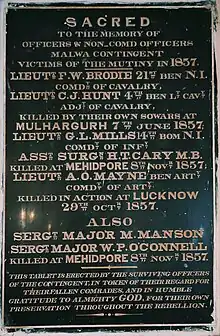| Sowar | |
|---|---|
| Sowar | |
| Country | Delhi Sultanate Deccan Sultanates Mughal Empire Maratha Empire British Raj India Pakistan |
| Branch | Cavalry |
| Equipment | Composite bow, Scimitar, Spear, and Musket |

A Deccani courtier, c.1600.

A sowar of the 6th Madras Light Cavalry, serving the British East India Company, c. 1845.
Sowar (Urdu: سوار, also siwar meaning "the one who rides" or "rider", from Persian sawār)[1] was originally a rank during the Mughal Empire. Later during the British Raj it was the name in Anglo-Indian usage for a horse-soldier belonging to the cavalry troops of the native armies of British India and the feudal states. It is also used more specifically of a mounted orderly, escort or guard. It was also the rank held by ordinary cavalry troopers, equivalent to sepoy in the infantry — this rank has been inherited by the modern armies of India and Pakistan.
History
An image from the Carnatic Wars features a Sowar armed with a Musket.
Sowar has been used as the name of a line of wrist-watches by the Swiss West End Watch Co.
See also
References
- This article incorporates text from a publication now in the public domain: Chisholm, Hugh, ed. (1911). "Sowar". Encyclopædia Britannica (11th ed.). Cambridge University Press.

Memorial plaque in Christ Church, Mhow, noting two officers who were "killed by their own sowars" in the Indian Rebellion of 1857.
This article is issued from Wikipedia. The text is licensed under Creative Commons - Attribution - Sharealike. Additional terms may apply for the media files.